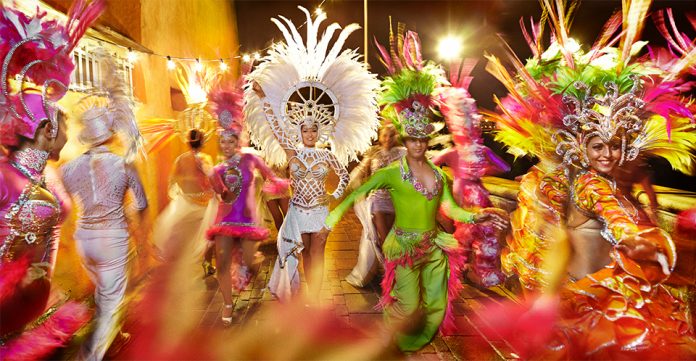
Christmas, New Year and Three Kings Day are all over at last, as is Blue Monday (16 January), which is the most depressing day of the year, according to a happy band of media reporters. It is now time to shake away those winter blues, search out a fabulous costume and get ready for Carnival – Canaries style!
Carnival has been celebrated across the Canary Islands since 1556 just before the Christian period called Lent, forty days before Easter, and often around Shrove Tuesday or Mardi Gras. Lent previously meant that Christians gave up eating meat, so just before this forty-day period the Canary Islanders were determined to take the term ‘party’ or fiesta to a higher level, which normally involves locals dressing up in fabulous costumes, when often men become women and women become men, just for the fun of it, and of course to have your photo taken.
The dates of Easter change each year and so the date of Carnival across the Canary Islands also changes, so that although the capital cities of each of the Canary Islands have the biggest parades and open air entertainment, many smaller towns also hold their own Carnival parades.
These parades have large floats that carry many in amazing costumes who often throw sweets or even offer those watching small cups of Canarian rum. Before the big parades there are also competitions for the best Carnival Queen (ladies), Carnival Dame (older ladies), Carnival Junior Queen (young girls) and of course the best Drag Queen (guess)!
There are also singing competitions called Murgas, when local people on each island sing songs that can often be very rude to those living on other islands. Carnival starts when a large sardine appears, and it ends when the sardine is taken out to sea, where it dies, and many spectators will be seen crying! It is an emotional and passionate event, often reflecting the partying frolics of the previous night!
Expat residents and tourists that visit during this Carnival period should make sure that they join in the party and learn more about local customs and traditions. There are many shops near tourist areas that sell good value Carnival costumes, so there is no reason why foreigners cannot join in the Canary Islanders’ celebrations.
Most municipalities have colourful posters that advertise the local events of Carnival, but some places tend to think that Carnival only involves local people, and they will already know when and where to go. The information shown on The Canary Islander website give dates and times for Carnival events in all the Canary Islands, but it is a good idea to check with local Tourist Information Offices too.
Take plenty of photos and selfies, because the rich cultural mix of Canary Islanders have strong connections with South America, Cuba and other Caribbean islands, which means that when Carnival comes to the Canary Islands it challenges the Carnival in Rio de Janeiro, and some think it is even better!
One word of warning for those visiting Santa Cruz in La Palma for Carnival! The locals also celebrate White Monday (the day before Shrove Tuesday), when locals only wear white clothes, and then after a certain signal, throw white talcum powder over everyone. Los Indianos celebrates Canary Islanders who were previously transported to Spanish colonies, and returned when they had become successful.
So there is a point to White Monday, but the talcum powder goes everywhere, and those with breathing problems should watch from a distance, as the powder storm spreads quickly and is not the healthiest substance to breathe in. Las Palmas in Gran Canaria also celebrates White Monday in the old streets of Triana and Vegueta, with special permission of the islanders of La Palma.
Carnivals in Las Palmas de Gran Canaria and Santa Cruz de Tenerife are often billed as “Second Only to Rio”, so if you really would like to take part in a huge, crazy, frivolous spectacle of colour and vitality, make sure you don’t miss it! You can find out more information and the dates of the largest events on the islands on The Canary Islander website: http://www.thecanaryislander.com/carnival.html
If you enjoyed this article, take a look at Barrie’s websites: http://barriemahoney.com and http://thecanaryislander.com or read his latest book, ‘Footprints in the Sand’ (ISBN: 9780995602717). Available in paperback, as well as Kindle editions.
© Barrie Mahoney




